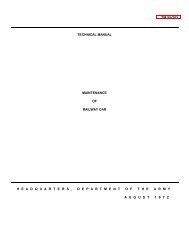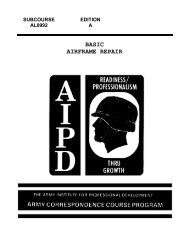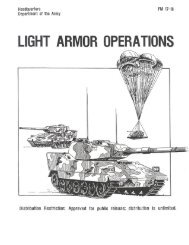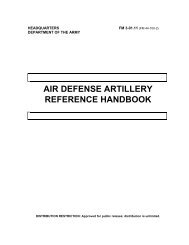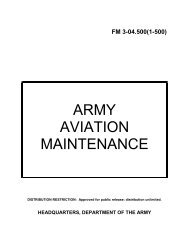fm 44-100 us army air and missile defense operations
fm 44-100 us army air and missile defense operations
fm 44-100 us army air and missile defense operations
Create successful ePaper yourself
Turn your PDF publications into a flip-book with our unique Google optimized e-Paper software.
FM <strong>44</strong>-<strong>100</strong><br />
Highly mobile <strong>and</strong> hardened assets with a self-s<strong>us</strong>taining capability will best<br />
accomplish this mission. A proper mix of systems will provide ADA coverage<br />
at all altitudes <strong>and</strong> allow the force conducting deep <strong>operations</strong> the maximum<br />
freedom to maneuver.<br />
6-83. Rear area <strong>air</strong> threats are predominantly UAVs, fixed-wing <strong>air</strong>craft, <strong>and</strong><br />
theater <strong>missile</strong>s with missions to destroy soft, immobile, high-value targets.<br />
These assets, which include aviation, C2, deep strike artillery, <strong>and</strong> logistics,<br />
are critical to corps <strong>and</strong> division <strong>operations</strong>. ADA planners deploy systems in<br />
rear areas that are less mobile, but have greater ranges to allow for early <strong>and</strong><br />
multiple engagements.<br />
6-84. The objective of ADA planning is to establish low- to high-altitude <strong>air</strong><br />
<strong>and</strong> <strong>missile</strong> <strong>defense</strong> coverage of the maneuver comm<strong>and</strong>er's <strong>defense</strong> priorities.<br />
The ADA comm<strong>and</strong>er m<strong>us</strong>t ensure horizontal <strong>and</strong> vertical integration<br />
throughout the operational area. ADA <strong>operations</strong> require synchronization<br />
with the supported force <strong>and</strong> coordination with higher <strong>and</strong> lower ADA echelons<br />
<strong>and</strong> adjacent ADA units. This often includes the integration of Army<br />
ADA plans with joint counter<strong>air</strong> <strong>and</strong> TMD <strong>operations</strong>. The METT-TC process<br />
influences integrated <strong>air</strong> <strong>and</strong> <strong>missile</strong> <strong>defense</strong> planning from theater through<br />
battalion level <strong>and</strong> permits reinforcement of the synchronization process.<br />
Scheme of Maneuver<br />
6-85. Corps <strong>and</strong> division comm<strong>and</strong>ers approve a scheme of maneuver developed<br />
by their staffs. The approved scheme of maneuver is normally one of<br />
several maneuver courses of action. Analysis of METT-TC, IPB, <strong>and</strong> the<br />
comm<strong>and</strong>er's intent forms the foundation for the maneuver concept. The<br />
comm<strong>and</strong>er's intent is provided as general guidance <strong>and</strong> direction to the staff<br />
on how to accomplish the mission. IPB includes the evaluation of both the<br />
ground <strong>and</strong> <strong>air</strong> threat. ADA <strong>and</strong> maneuver planning incorporates possible<br />
threat courses of action. Appendix A describes the development of <strong>air</strong> IPB in<br />
greater detail. The AMDCOORD develops an estimate that includes <strong>air</strong> <strong>defense</strong><br />
coverage for each maneuver course of action (appendix B).<br />
Air <strong>and</strong> <strong>missile</strong> <strong>defense</strong> Priorities<br />
6-86. The ADA comm<strong>and</strong>er considers METT-TC, IPB, <strong>and</strong> the supported<br />
comm<strong>and</strong>er's intent <strong>and</strong> concept of <strong>operations</strong> as he develops AMD priorities.<br />
Priorities are based on the factors of criticality, vulnerability, recuperability,<br />
<strong>and</strong> the threat (CVRT). The ADA comm<strong>and</strong>er recommends these priorities to<br />
the maneuver comm<strong>and</strong>er for approval.<br />
ADA Concept of Operations<br />
6-87. The purpose of the ADA concept of <strong>operations</strong> is to maximize protection<br />
of the force. The ADA comm<strong>and</strong>er assesses the factors of METT-TC, the force<br />
comm<strong>and</strong>er's intent, the IPB, <strong>and</strong> the approved <strong>air</strong> <strong>and</strong> <strong>missile</strong> <strong>defense</strong> priorities<br />
to determine the numbers <strong>and</strong> types of ADA resources necessary to<br />
protect those priorities. To design that <strong>defense</strong>, the comm<strong>and</strong>er m<strong>us</strong>t apply<br />
the <strong>air</strong> <strong>defense</strong> employment principles <strong>and</strong> guidelines, <strong>and</strong> the technical considerations<br />
of these resources. The ADA concept of <strong>operations</strong> is the basis of<br />
the <strong>air</strong> <strong>and</strong> <strong>missile</strong> <strong>defense</strong> plan <strong>and</strong> is synchronized with the higher <strong>and</strong> adjacent<br />
AD plans (figure 6-5). Major considerations that impact on the devel-<br />
6-19




